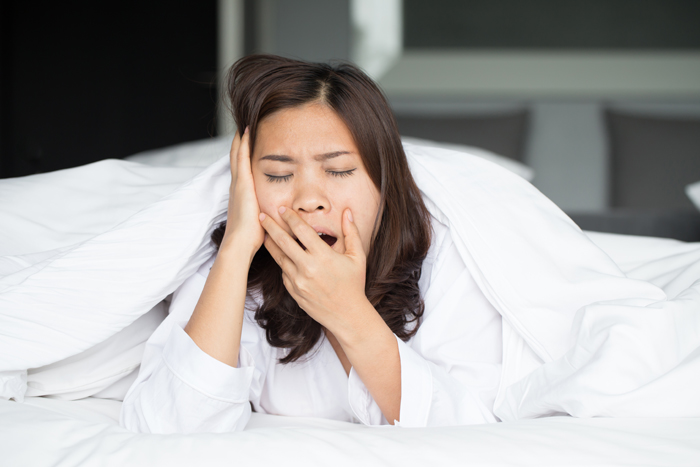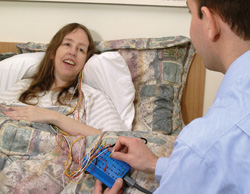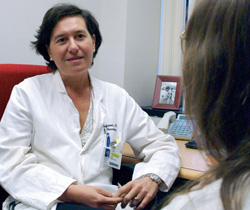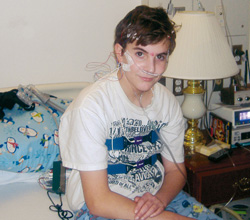
Not Enough ZZZzzzs?

In people with neuromuscular diseases, testing for sleep-breathing problems can be tricky but worth it
Do you suffer from sleep disturbances — snoring, choking or gasping, or restless tossing and turning?
Do you wake up in a sweat in the middle of the night, or arise in the morning feeling fatigued, or with headaches, sore throat or dry mouth?
Do you experience memory and concentration problems, or find you’re excessively sleepy during the day, falling asleep when you normally shouldn’t, such as during eating, talking or driving?
If you answered yes to one or more of these prompts, you may want to talk to your physician about the possibility that you’re experiencing nighttime breathing problems, and discuss how to go about determining whether that’s the case. Not only do untreated sleep-breathing problems interfere with daytime activities, but some research also suggests that they may actually contribute to muscle weakness.
Sleep apnea and neuromuscular disease
 Some studies have shown a high incidence of sleep respiratory problems in people with neuromuscular diseases. But the cause of these problems may be different than for those without these types of diseases.
Some studies have shown a high incidence of sleep respiratory problems in people with neuromuscular diseases. But the cause of these problems may be different than for those without these types of diseases.
Among the general population, common causes of respiratory problems during sleep include pauses in breathing (apnea) either caused by brain abnormalities (called central apnea), or by collapse of the upper airway, blocking breathing (called obstructive apnea).
But for those with neuromuscular diseases, breathing problems during sleep may be caused or complicated by the fact that the muscles that aid respiration — the diaphragm and intercostals (between the ribs) — have been weakened by disease.
Weak respiratory muscles can lead to nocturnal hypoventilation (ineffective breathing during sleep) or nocturnal apnea (periodic cessation of breathing during sleep), when gravity, body position and neurological factors naturally make breathing efforts less effective.
Apnea diagnosis and neuromuscular disease
A simple method used to assess nighttime breathing difficulties is to measure exhaled carbon dioxide in combination with pulse oximetry, which painlessly measures blood oxygen levels through the placement of a small clip on a finger or toe. Typically these tests may be done at home, overnight while the person sleeps.
A more sophisticated assessment tool is a sleep study or polysomnogram (PSG), which pinpoints the causes of fragmented or disrupted sleep through a combination of measurements, including: encephalographic (brain) activity, eye movement, muscle activity, heart rhythm, respiratory effort, nasal and oral airflow, oxygen saturation, carbon dioxide levels, limb movements and snoring. Polysomnograms are performed in a specialized sleep laboratory or sleep center, and can last several hours. (See “If your physician prescribes a polysomnogram” in section below)
Sleep apnea treatments and neuromuscular disease
For the general population, continuous positive airway pressure, or CPAP, is the ventilation therapy commonly prescribed for obstructive apneas. CPAP blows in a continuous flow of air at a set pressure, keeping the airway from collapsing and obstructing breathing.
But for people whose problem is caused by weak respiratory muscles, bilevel positive airway pressure ventilation, typically called BiPAP, is more commonly used. (BiPAP is a registered trademark of Respironics.) Air is administered at a higher pressure level on inhalation and a lower (or zero) pressure on exhalation, so the patient doesn’t have to breathe out against pressure – something that’s difficult to do with weakened respiratory muscles.
In muscle diseases, the BiPAP “span,” or difference between the inhalation and exhalation airflow pressures, is typically high to provide greater assistance to the inspiratory muscles and little or no resistance during exhalation.
Because ventilation therapies for people with weak muscles are different than those used for obstructive apneas, it’s important that your physician is highly skilled at analyzing test results and knows which therapeutic solutions are appropriate for people with neuromuscular diseases.
Sleep studies valuable? No ...
When respiratory muscle weakness causes nighttime breathing problems, it doesn’t take a polysomnogram to diagnose it, says John Bach, a physical medicine and rehabilitation specialist at University Hospital in Newark, N.J.
In patients with neuromuscular disease, Bach determines the need for ventilatory therapy by assessing symptoms and measuring exhaled carbon dioxide and vital capacity while the person is sitting and lying down. If those measurements don’t yield useful information in the clinic, he has patients do them at home overnight.
Patients showing signs of hypoventilation should be offered a trial of nocturnal ventilation, Bach advises, “and if they feel better using it, let them do so.”
Bach questions the usefulness of polysomnograms for people with muscle diseases because the test “interprets all abnormalities as central or obstructive apneas rather than muscle weakness,” he says — especially when read by physicians unfamiliar with neuromuscular disease.
This misdiagnosis then leads to improper treatment, he says.
“All symptomatic, weak patients need full nocturnal inspiratory muscle rest with very high-span BiPAP or use of portable ventilators to fully rest muscles — not CPAP, oxygen or low-span BiPAP,” Bach says. “Treat the patient, not the polysomnogram.”
David Rye, professor of neurology at Emory University in Atlanta and director of the Emory Healthcare Program in Sleep Medicine, echoes Bach’s concerns about the possibility for misinterpretation of sleep study results.
“There is really nothing that directly measures ‘effort’ or ‘depth’ of breathing on the sleep study,” he says. “It takes a very trained eye to pick it up. Thus, most patients probably get put on CPAP but would do better on BiPAP.”
... or yes
Unlike Bach, however, Rye says polysomnograms can be very helpful in evaluation and that they aren’t ordered frequently enough.
Rye finds that PSGs are sensitive to the earliest signs of nocturnal hypoventilation, which, in neuromuscular disease, typically express themselves first in the rapid eye movement (REM) phase of sleep when muscle tone is low and respiratory function is most dependent on the diaphragm.
He notes that physicians often wait until patients are showing hypoventilation symptoms such as those listed at the beginning of this article before ordering tests, when in fact earlier sleep studies might prove valuable in treating muscle diseases.
Physicians are “probably treating later in the course [of the disease], and it’s unclear whether earlier recognition and treatment of sleep-disordered breathing would really change the course of the disease,” says Rye. “Those studies are needed.”
One study that lends credence to Rye’s speculation was done by MDA grantee Tejvir S. Khurana at the University of Pennsylvania, and colleagues. Khurana’s team has preliminary evidence that insufficient oxygen (hypoxia) causes damage to respiratory and other muscles. Khurana hypothesizes that weakened respiratory muscles cause hypoxia, which then weakens the muscles further, setting up a vicious cycle.
Maybe yes, maybe no
 Oximetry can detect if your oxygen goes down at night, but it’s not as sophisticated as a sleep study because it doesn’t tell you why the oxygen goes down,” says Emma Ciafaloni, a neuromuscular neurologist at the University of Rochester in Rochester, New York. “Oximetry is useful, but rudimentary — it only tells you part of the story.”
Oximetry can detect if your oxygen goes down at night, but it’s not as sophisticated as a sleep study because it doesn’t tell you why the oxygen goes down,” says Emma Ciafaloni, a neuromuscular neurologist at the University of Rochester in Rochester, New York. “Oximetry is useful, but rudimentary — it only tells you part of the story.”
Ciafaloni says she often orders polysomnograms for her patients with neuromuscular diseases, but cautions that the tests can be misinterpreted in this population. “It’s a very understudied area. There are no guidelines. Nobody has really looked in a systematic way to see what exactly the needs are and what should be done with the results of the polysomnogram.”
She adds, “My opinion is we probably should order more polysomnograms than we currently do. In patients with neuromuscular diseases, if their doctor proposes that they have a sleep study, I would take that as a positive thing, because most of the neuromuscular diseases essentially put you at risk of hypoventilation at night.”
Ciafaloni points out that, because most neuromuscular diseases have no treatment or cure, anything that can be done to improve quality of life should be done.
“For example, take fatigue,” she says, noting that fatigue can be caused by more than just muscle weakness. “It could be because [the person] is hypoventilating at night, and that portion is fixable. Early on, it could really make a big difference in the life of the patient. Sleep apnea or hypoventilation at night could be the cause, and we can help.”
For that reason, Ciafaloni says polysomnograms should be ordered more frequently and sooner in the course of disease. If people have access to it, and their physician orders it, she adds, “they should go for it.”
Also of the opinion that oximetry isn’t sufficient in testing for nighttime breathing problems is neurologist Michael Yurcheshen of the University of Rochester’s Strong Sleep Disorders Center, who says the biggest concern with patients with neuromuscular disease and nocturnal breathing difficulties is that “they do not present often enough to sleep disorders specialists.”
Like Ciafaloni, Yurcheshen says inpatient sleep studies give more complete information than oximetry alone.
“In this community and others, patients are prescribed BiPAP on the basis of nocturnal oximetry alone,” Yurcheshen says. “Although this is a reasonable screen for sleep-disordered breathing, it is by no means complete. The breathing picture in these patients is often much more complex.”
Yurcheshen says BiPAP is “a very good treatment, especially in those patients with hypoventilation.” He cautions against the prescription of BiPAP, however, without consultation from a sleep specialist, and without a monitored BiPAP titration (a test used to determine the most effective ventilator pressure settings), in order to ensure the most effective treatment with positive airway pressure therapy.
The bottom line
Make sure you get a knowledgeable interpretation of a polysomnogram — or any other evaluation for problems associated with nighttime breathing issues says Nancy Collop, a pulmonary medicine and critical care physician at Johns Hopkins University and a board member of the American Academy of Sleep Medicine.
“There are clearly nuances [in sleep studies] that might be missed or misinterpreted by people with inadequate expertise,” Collop says. She suggests consulting an experienced, certified sleep specialist who knows both the patient’s history and the effects of neuromuscular disease on sleep and breathing.
Donna says going through the sleep studies has been easy in comparison with everything else she and her family have been through in dealing with mitochondrial myopathy, though she admits it was “nerve-wracking in a sense,” not knowing what the results might bring.
“It confirmed, but it also comforted,” she admits, explaining that the greatest benefit to having the sleep studies done was getting answers to explain some of her children’s symptoms.
Sleep studies have made a difference in helping Donna and her family live with neuromuscular disease, and she recommends the studies as a positive and valuable tool in the search to find treatments that will improve the daily lives of those with neuromuscular diseases.
“Getting a good night’s sleep and having it be the best sleep and most restful type of sleep allows [the kids] to conserve some energy so they start the day feeling a little better,” Donna explains, adding, they “can get that little extra boost and actually be able to play a bit more, learn a little more and simply have some fun. Instead of running on empty their whole day, they get to experience a little more.”
“It’s very important – it can save a life,” she says. “It honestly makes the quality of life so much better.”
Better Nights = Better Days
 Donna Thorell, 41, of North Carver, Mass., has had a polysomnogram, as have all five of her children: Joshua, 20; Kristofer, 18; Timothy, 16; Lianna, 10; and Reilly, 6.
Donna Thorell, 41, of North Carver, Mass., has had a polysomnogram, as have all five of her children: Joshua, 20; Kristofer, 18; Timothy, 16; Lianna, 10; and Reilly, 6.
The Thorells all have mitochondrial myopathy; Timothy received a confirmed diagnosis following a muscle biopsy in 2005, and the rest received their diagnoses based on clinical symptoms.
Kristofer was the first to have a polysomnogram, in 2001.
“We knew that he had a muscle disease — we weren’t sure what at the time,” Donna says, adding that the results of Kristofer’s polysomnogram were a piece of the puzzle that “put us on the path to figuring out it was mitochondrial myopathy.”
Joshua, Kristofer and Timothy all use nighttime ventilation. Lianna also has been prescribed nighttime ventilation, but must have a titration sleep study first, where a sleep physician will test to determine which pressure settings work best to improve her breathing and, by extension, her sleep.
What's a Sleep Lab?
- Polysomnograms are conducted at special sleep laboratories with academic or hospital affiliation, or in independently located and operated facilities.
- Sleep labs often are set up to resemble a bedroom in order to help participants feel at ease. A sleep technician hooks patients up to the monitoring and recording devices, and then monitors the patient throughout the study. If a problem is detected, a second sleep study will be scheduled to determine the best method of therapy.
- Sleep labs that have demonstrated compliance with set standards in areas such as testing procedures, patient safety, and physician and staff training may be awarded accreditation by the American Academy of Sleep Medicine (AASM) or the Joint Commission on Accreditation of Healthcare Organizations (JCAHO).
- "The goal behind accreditation is safety and quality care," says sleep expert Sam Fleishman of the Sleep Center at Cape Fear Valley Medical Center, Fayetteville, N.C.
- Fleishman notes that sleep labs and centers don't have to be accredited, but that "payers (insurance companies) are increasingly requiring sleep labs and centers be accredited for coverage to apply."
- Knowing a lab is accredited, Fleishman says, should assure people they'll receive quality care by professionals who have passed strict standards. It means "they're following evidence-based medicine," he says, "not flying by the seat of their pants."
If Your Physician Prescribes a Polysomnogram ...
- You likely will be scheduled for an evening appointment, although some sleep labs offer morning or daytime tests to accommodate shift workers or those with atypical schedules.
- The day of your exam, follow your normal routine and diet. You should take all medications according to schedule unless your physician advises otherwise. You may be directed to avoid naps and large quantities of caffeine.
- At the sleep laboratory, you will be fitted with various sensors, then attempt to go to sleep as you would any other night. The sensors transmit information such as oxygen levels and air movement to monitoring/recording equipment. The entire process usually takes seven to 12 hours.
- The wait time for results may vary from several hours to several weeks. Procedures also will vary by institution. In some cases, you may meet with a sleep physician from the sleep lab to discuss results. In other cases, results may be forwarded to the prescribing physician; they also may be handled jointly between the two.
- Insurance plans typically cover polysomnograms. Dr. Lawrence Epstein, medical director of Sleep Health Centers in Brighton, Mass., and a board member of the American Academy of Sleep Medicine, says most insurance companies have “some qualifications on what you want to look for in a sleep study.” These include sleep-breathing problems such as obstructive sleep apnea, movement disorders such as periodic limb movement, and seizure disorders. Problems such as insomnia, which can be diagnosed based on clinical history, typically are not covered. “As long as it’s for an appropriate indication,” Epstein notes, “all insurance companies (as well as Medicaid and Medicare) will pay for sleep studies.” Co-payments or deductibles vary.
MDA Resource Center: We’re Here For You
Our trained specialists are here to provide one-on-one support for every part of your journey. Send a message below or call us at 1-833-ASK-MDA1 (1-833-275-6321). If you live outside the U.S., we may be able to connect you to muscular dystrophy groups in your area, but MDA programs are only available in the U.S.
Request Information